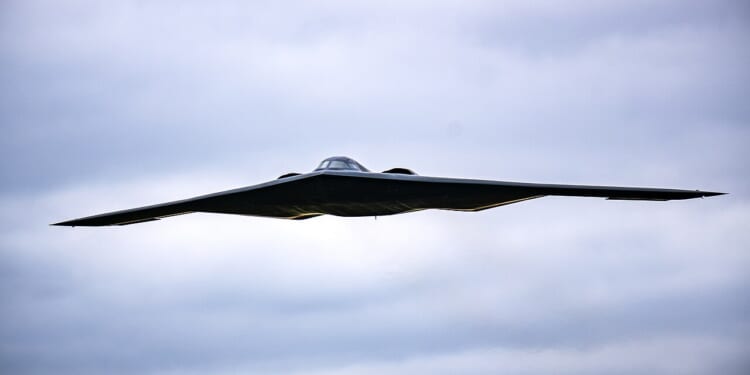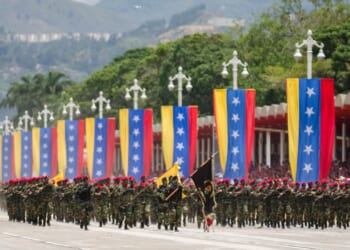Owing to its obvious lack of aerodynamics, the B-2’s flight envelope is fairly narrow—but within it, the bomber is designed to be gentle and responsive.
The B-2 Spirit is one of the most aerodynamically distinct aircraft ever built—a true flying wing, with no tail and no vertical fins, only a vast blended body with a low, smooth silhouette designed to avoid radar detection.
The shape has advantages in stealth, and in aerodynamic efficiency, but it also leaves the airframe inherently unstable. What makes the B-2 flyable is a computerized fly-by-wire system, which results in giving the pilot a calm, deliberate, and precise flying experience.
The B-2 Spirit’s Specifications
- Year Introduced: 1997
- Number Built: 21 (19 still operational)
- Length: 69 ft (21.0 m)
- Wingspan: 172 ft (52.4 m)
- Weight (MTOW): ~336,500 lb (152,200 kg)
- Engines: Four General Electric F118-GE-100 turbofans (~17,300 lbf thrust each)
- Top Speed: ≈630–650 mph (~1,010–1,045 km/h) / ~Mach 0.95
- Range: ~6,000 nmi (6,900 mi, 11,112 km) unrefueled (intercontinental with aerial refueling; global reach)
- Service Ceiling: ~50,000 ft (15,240 m)
- Loadout: Internal weapons bays; roughly ~40,000 lb (≈18,000 kg) of ordnance — nuclear and conventional mission sets (B61/B83 certified historically), precision-guided bombs (JDAM, SDB), and select standoff munitions depending on loadout
- Aircrew: 2 (pilot and mission commander)
Flying the B-2 Is Like Flying a Glider
From the cockpit, the B-2 is known to behave like a large, high-performance glider at cruise. The controls are reported to be “soft,” with the aircraft responding smoothly to small stick inputs, without any of the twitchiness one would expect from such an inherently unstable platform.
These benign and docile flight characteristics are, of course, an illusion. They can only be achieved through the advanced fly-by-wire control computers that are making hundreds of micro-adjustments per second to the plane’s trajectory. These computers sample sensors and actuators continuously, translating the pilot’s intentions into coordinated deflections across many control surfaces so the aircraft stays balanced without a vertical stabilizer.
That lack of a vertical stabilizer—better known as the aircraft’s tail—means the B-2 cannot rely on a single large control surface for yaw control. Instead, the B-2 must rely on split-rudder drag flaps at the wingtips—surfaces that open asymmetrically to create differential drag and provide directional authority without vertical fins. Pitch and roll, meanwhile, are managed with a matrix of elevons and spoilers distributed along the wing. Because these surfaces must serve multiple roles (trim, maneuvering, load control, and stealth-friendly deflection limits), the flight computer must balance sometimes conflicting demands: maintaining low observability, preserving control margins, and keeping handling predictable for the crew.
In the B-2’s Design, Stealth Always Comes First
The B-2’s handling matrix is highly bounded by stealth considerations. The aircraft’s radar-absorbent materials, planform alignment, and engine inlet shielding all perform best—that is, maintain their low observability—when the B-2 stays within very specific speed, altitude, and bank-angle envelopes. Rapid, aggressive maneuvers are not permitted, as they can significantly change the plane’s reflective geometry and expose hot engine faces, increasing its radar and infrared signatures. Pilots are taught to fly accordingly, with clear procedural limits to maintain stealth performance: moderate bank angles, steady climb and descent profiles, and cruise at altitudes and speeds that preserve the B-2’s low-observable signature.
In short, the B-2’s performance is constrained for the sake of preserving stealth—and the flight controls are calibrated accordingly, to give the pilot the authority needed for mission demands but without permitting signature-compromising behavior.
From a technical perspective, the mission’s demands inform the B-2’s flight envelope. The bomber typically cruises at Mach 0.75 to Mach 0.8 at altitudes between 40,000 and 50,000 feet, where lift-to-drag is favorable and engines operate efficiently. The wing’s broad chord and low wing-loading produce strong sustained-lift characteristics, meaning the B-2 loses less energy in turns and can hold long transits with good fuel economy—vital for the global, long-range missions the platform was designed to complete.
So maneuvering and raw performance are not the hallmarks of the B-2’s flight behavior. But the aircraft is stable and predictable, adept at maintaining low stealth signatures while completing strategic strike missions at inter-continental distances.
About the Author: Harrison Kass
Harrison Kass is a senior defense and national security writer at The National Interest. Kass is an attorney and former political candidate who joined the US Air Force as a pilot trainee before being medically discharged. He focuses on military strategy, aerospace, and global security affairs. He holds a JD from the University of Oregon and a master’s in Global Journalism and International Relations from NYU.
Image: Wikimedia Commons.


















